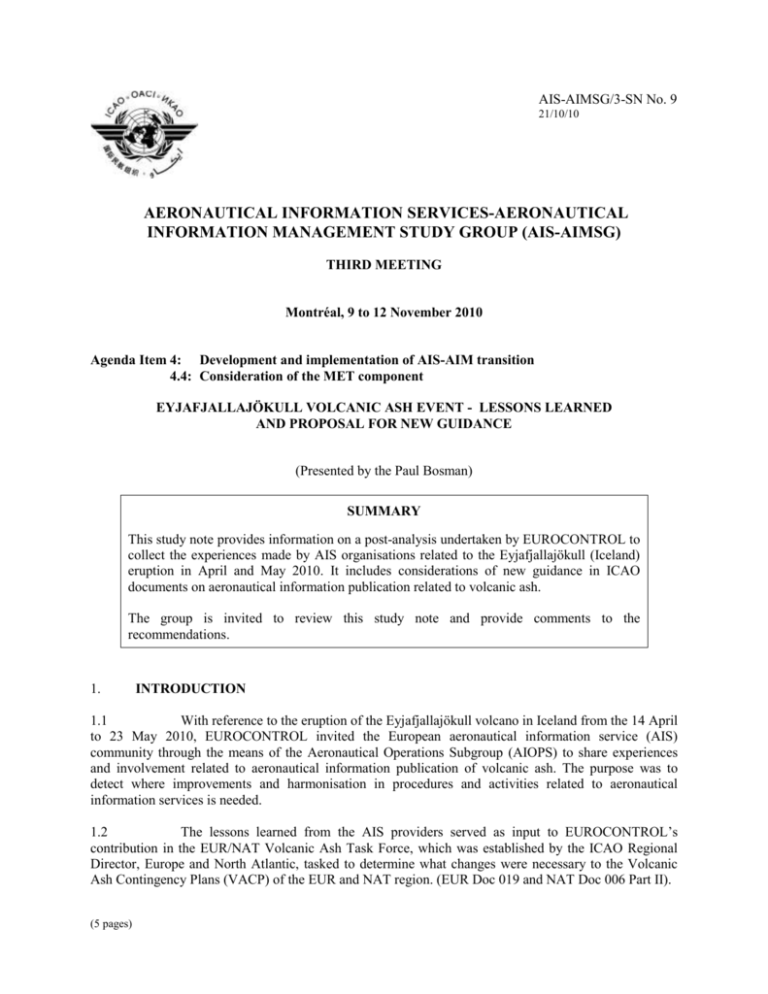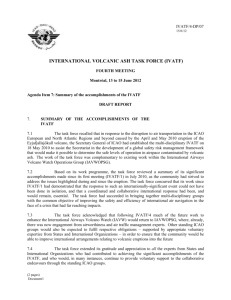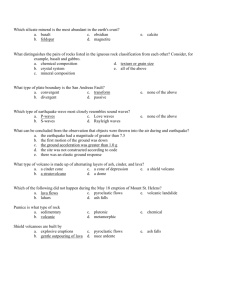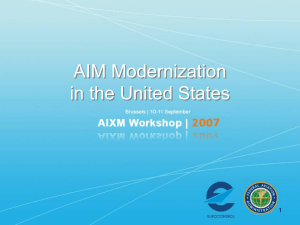EYJAFJALLAJÖKULL VOLCANIC ASH EVENT - LESSONS
advertisement

AIS-AIMSG/3-SN No. 9 21/10/10 AERONAUTICAL INFORMATION SERVICES-AERONAUTICAL INFORMATION MANAGEMENT STUDY GROUP (AIS-AIMSG) THIRD MEETING Montréal, 9 to 12 November 2010 Agenda Item 4: Development and implementation of AIS-AIM transition 4.4: Consideration of the MET component EYJAFJALLAJÖKULL VOLCANIC ASH EVENT - LESSONS LEARNED AND PROPOSAL FOR NEW GUIDANCE (Presented by the Paul Bosman) SUMMARY This study note provides information on a post-analysis undertaken by EUROCONTROL to collect the experiences made by AIS organisations related to the Eyjafjallajökull (Iceland) eruption in April and May 2010. It includes considerations of new guidance in ICAO documents on aeronautical information publication related to volcanic ash. The group is invited to review this study note and provide comments to the recommendations. 1. INTRODUCTION 1.1 With reference to the eruption of the Eyjafjallajökull volcano in Iceland from the 14 April to 23 May 2010, EUROCONTROL invited the European aeronautical information service (AIS) community through the means of the Aeronautical Operations Subgroup (AIOPS) to share experiences and involvement related to aeronautical information publication of volcanic ash. The purpose was to detect where improvements and harmonisation in procedures and activities related to aeronautical information services is needed. 1.2 The lessons learned from the AIS providers served as input to EUROCONTROL’s contribution in the EUR/NAT Volcanic Ash Task Force, which was established by the ICAO Regional Director, Europe and North Atlantic, tasked to determine what changes were necessary to the Volcanic Ash Contingency Plans (VACP) of the EUR and NAT region. (EUR Doc 019 and NAT Doc 006 Part II). (5 pages) AIS-AIMSG/3-SN No. 9 -2- 1.3 This study note provides the results of the AIS consultation, and makes a reference to the revision to the ICAO Volcanic Ash Contingency Plan (VACP) of the EUR and NAT region, where a number of AIS improvement proposals were taking into account. However, based on the AIS comments, further enhancement in ICAO AIS guidance material is proposed for consideration by the AIS-AIM Study group. 2. 2.1 DISCUSSION AIS Consultation and Lessons learned 2.1.1 Within many European AIS organizations, procedures are established for the event of volcanic ash. In most cases the procedures are based on the EUR/NAT ICAO VACP, upon which local contingency plans are built including service level agreements with the local meteorological (MET) service provider and the air traffic management (ATM) organisation. A number of AIS have participated in ICAO volcanic ash exercises. NOTAM templates for volcanic ash publication are established in some States, and a few States reported that they are included in the local crises coordination team established at area control centre (ACC) level. 2.1.2 Although established procedures exist, in the real life situation it was clear that improvement in cooperation within the organisations is needed. Refinement of pre-defined contingency procedures, strengthening the role and early involvement of AIS in the overall ATM organisation and in the local crisis management is seen essential. In particular, it is important to expose the AIS/NOF as a coordination partner in the procedures related to publication of NOTAM, where the roles of ATS as originator and the AIS NOF as issuer of the NOTAM are clearly defined. 2.1.3 A major improvements area is uniformity in origination and dissemination of NOTAM information related to airspace and routes closure, flight level restrictions and other areas where operational measures are required. It was seen essential not only for AIS responsible for issuing the NOTAM, but also confirmed by AIS colleagues not impacted by the volcanic ash cloud, meeting the airspace users in need of relevant and coherent pre-flight information. 2.1.4 In addition to NOTAM, a few States published AIC with requirements for approval of operations in the different established volcanic ash zones. States pre-flight briefing portals on the internet and the CFMU Network Operations Publication Portal were frequently used by the AIS organisations for retrieving information on the status of the volcanic ash cloud and on affected airspace and airports. 2.1.5 The current practices where the volcanic ash advisories, volcanic SIGMET and NOTAM are forming the reporting process have been followed in most States. 2.2 Proposed enhancement of NOTAM templates in ICAO documentation 2.2.1 A comprehensive revision to the common VACP of the EUR and NAT Regions was adopted by the European Air Navigation Planning Group (EANPG) and North Atlantic Systems Planning Group (NAT SPG) in July 2010, including a stronger position of the AIS and MET functions in the ATM organisations volcanic ash contingency planning. The Appendix I to the plan, containing templates populated for SIGMET, NOTAM and ASHTAM was released 26 August 2010. -3- AIS-AIMSG/3-SN No. 9 2.2.2 The NOTAM templates allow insertion of distances related to danger areas, established by the Provider State, leaving the distance value open in the template. The plan describes that as well as establishing danger areas, States are not prevented from establishing restricted or prohibited areas, if considered necessary by the State concerned. 2.2.3 The VACP states that in addition to providing the status of activity of the volcano, NOTAM/ASHTAM can also provide information on air routes and flight levels affected and to limit access to the airspace affected by the volcanic ash. No NOTAM examples are provided for publication of this information, but instead a reference to Annex 15 for guidance is made. 2.2.4 Uniformity in format and content of NOTAM information related to the above mentioned subjects was seen as an important improvement area, with respect to the Eyjafjallajökull volcanic ash event. Although the reference in the VACP to ICAO is valid, expanded examples in ICAO Annex 15 for the mentioned subjects to promote harmonisation in NOTAM information, is a subject for consideration by the Study Group. 2.3 Considerations of the ASHTAM message 2.3.1 Current ICAO provisions allow the issuance of ASHTAM alongside NOTAM, Volcanic Ash SIGMET and Volcanic Ash Advisory (VAA). In the post-analysis, it was observed that no ASHTAM was issued by States for the Eyjafjallajökull event. Instead, regular NOTAM was issued on the ash cloud itself, as well as for the airspace- route and flight level restrictions related to the event. 2.3.2 Consultation with the Group EAD on the global use of the ASHTAM message gave that a small number is issued for volcanic ash on a global basis and in the European region in particular. In 2009, a total of 647 ASHTAM were published globally, where four of those were issued in the European region (Italy) for test purposes. 2.3.3 The current ICAO provisions states that when used, the ASHTAM shall include the status of activity of a volcano that is of operational significance. In the event of a volcanic eruption the ASHTAM can also provide information on the routes and airspace affected. In the current publication chain, the ASHTAM content with respect to the ash cloud is based on published SIGMET or VAA information. However, in the Eyjafjallajökull volcanic event, the NOTAM was seen more appropriate as publication means for both the ash cloud and the affect on operations. 2.3.4 Due to the great variance in global implementation, consequently the limited number of published ASHTAM messages, and concerns with respect to the duplication of published information, it is proposed to the AIS-AIMSG to reconsider the current global provisions for the ASHTAM. 2.3.5 Hereby the capability of the NOTAM format compared to the ASHTAM in filtering and selecting messages based on the NOTAM Q-code and the dedicated series for volcanic ash related information should be taken into consideration. 2.3.6 It is recognised, despite the above mentioned issues, that based on consequential disruption on air traffic and the information needed to be promulgated, the publication of ASHTAM is the preferred means of information exchange in a region. In these circumstances, the issuance of NOTAM for volcanic ash cloud information and/or operational measures as a consequence of the ash should be prohibited for that region to avoid duplication of information. Consequently, when NOTAM is used, ASHTAM shall not be used in the region. AIS-AIMSG/3-SN No. 9 -4- 2.3.7 Consideration should be given for the inclusion of this distinct choice between ASHTAM or NOTAM in the Regional Air Navigation Plans and the enabling provisions in Annex 15. 2.3.8 With reference to ICAO Annex 15 section 5.3.4 the current provisions require to include volcanic ash advisory centres (VAACs), SADIS and international satellite communications system (ISCS) in the global exchange of ASHTAM. It is important to note the imposed constraints related to the ASHTAM message format with respect to the international exchange between the different communications’ domains of Aeronautical Fixed Services (AFS) and the Global Telecommunication System (GTS). 2.3.9 The abbreviated header of the AFTN message indicating the geographical indicator, serial number and date-time group do not correspond to the World Meteorological Organisations (MWO) Publication No 386 type header. Delivering ASHTAM and NOTAM messages using this format to those listed in 5.3.4 is not possible from a routeing perspective, nor is it possible to process it in end systems which are expecting a standard WMO abbreviated header. 2.3.10 The existing limitations are factors that should be taken into consideration in the discussion of use of the ASHTAM and current duplication of published information, taking into account the volcanic ash SIGMET and VAA. 3. RECOMMENDATION 3.1 As a consequence of the lessons learned by the European States AIS organisations regarding the need for harmonisation in management of NOTAM related to a volcano eruption event, it is proposed that the ICAO guidance material is enhanced to include examples a series of NOTAM related to the operational impact and limited access of airspace and routes affected by the volcanic ash, covering the flowing areas: airspace closure airport closure airspace restrictions restriction related to VFR/IFR recommended NOTAM codes (Q-code ) for the relevant subject 3.2 The templates should take into account the ongoing progress in the digital NOTAM developments, by which the information can be provided in a digital format (AIXM) suitable for automated computer processing. This will enable visualisation of the aeronautical information, for example restriction areas and closed airspace. 3.3 The study note recommends reconsidering the ASHTAM format as a suitable means for notification of volcanic ash in ICAO SARPS with regards to the duplication of published information on volcanic ash by the SIGMET and NOTAM. 3.4 Considering that discussions are held within the ICAO International Volcanic Ash Task Force (IVATF) to determine common methodology for airspace description for dissemination by SIGMET and NOTAM/ASHTAM, it would be useful to report back to the IVATF the conclusions if the Subgroup discussions. -54. AIS-AIMSG/3-SN No. 9 ACTION BY THE GROUP 4.1 The AIS-AIMSG is invited to consider and discuss the content of this paper, and provide comments based on the recommendations on: a) the drafting of NOTAM templates (keeping in mind the work on the digitising of NOTAM information) related to the operational impact and limited access of airspace and routes affected by the volcanic ash; b) reconsidering the ASHTAM and NOTAM publication for notifications on volcanic ash; and c) providing feedback to the IVATF. — END —









